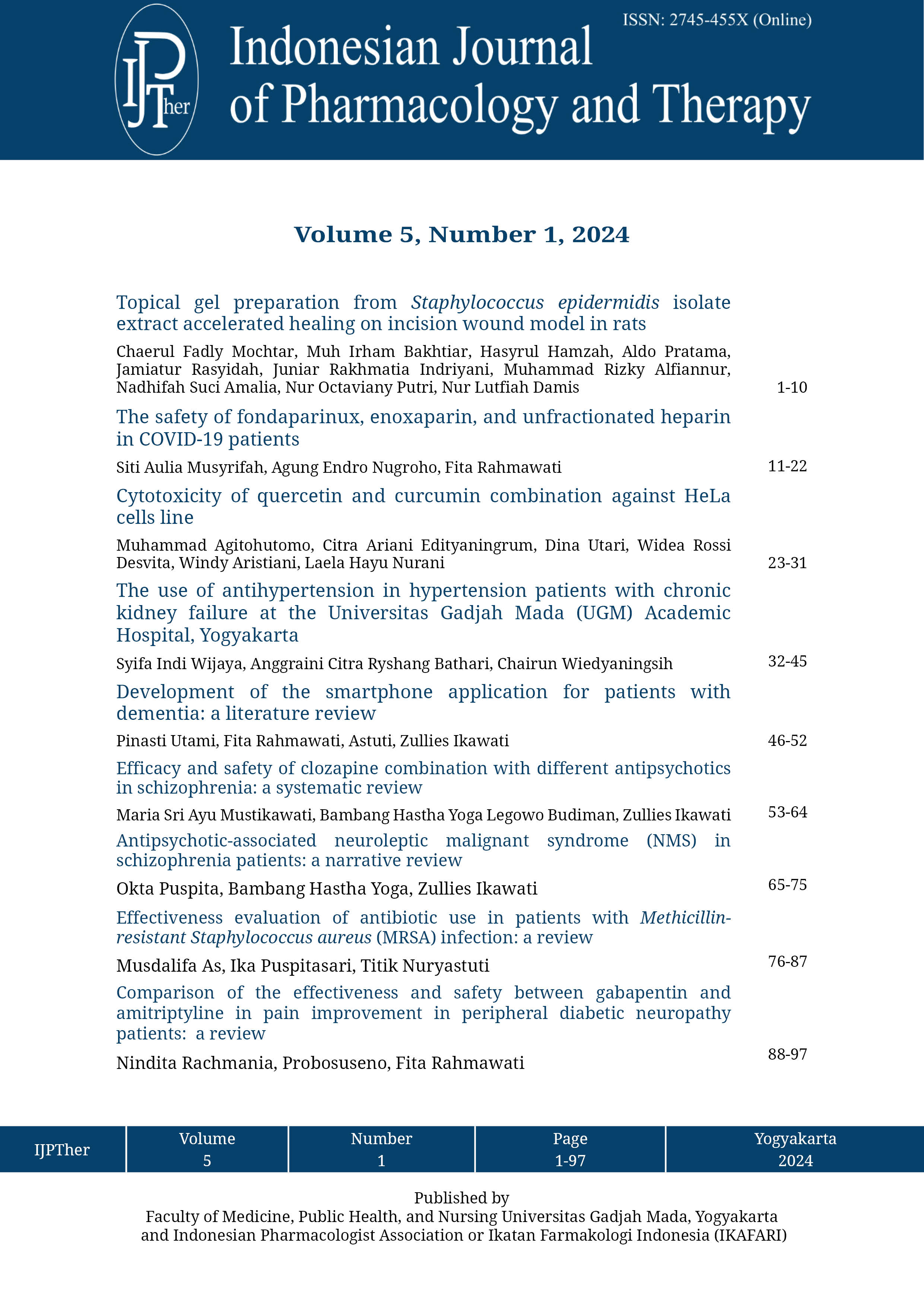Cytotoxicity of quercetin and curcumin combination against HeLa cells line
Abstract
Curcumin and quercetin combination are potential candidates for anticancer. Previous studies reported this combination active against several cancer cells including breast cancer, myeloid leukemia, and melanoma. However, the activity of this combination against cervical cancer has not been reported, yet. This study aimed to evaluate the cytotoxicity of the combination of curcumin and quercetin against HeLa and Vero cells. MTT assay was applied to evaluate cell growth inhibition. The inhibitory 50% concentration (IC50) of curcumin and quercetin on HeLa and Vero cells was determined and the selectivity index (SI) was then calculated. Combination index (CI) was calculated after evaluation of the cytotoxicity of the curcumin and quercetin combination at various concentration of 1 IC50, ½ IC50, and ¼ IC50. The IC50 of the curcumin against the HeLa and Vero cells were 26.57 ± 2.00 μM and 73.89 ± 12.93 μM with a SI of 2.78. Whereas the IC50 of the quercetin against the HeLa and Vero cells were 149.52 ± 21.09 μM and 1094.47 ± 15.68 μM with a SI of 7.32. The CI of combinations of curcumin and quercetin at concentrations of ¼ IC50 was 0.78 indicating a mild-moderate synergistic effect, whereas the combination at a concentration of 1 IC50 or ½ IC50, the CI value was >0.9 indicating an antagonistic effect.
References
Agustiansyah P, Sanif R, Nurmaini S, Irfannuddin, Legiran. Epidemiology and risk factors for cervical cancer. Bioscientia Medicina: J Biomed Trans Res 2021;5(7):624–31. https://doi.org/10.32539/bsm.v5i7.326
Rani DM, Wongso H, Purwoko RY, Winarto NB, Shalas AF, Triatmoko B, et al. Anti-cancer bioprospecting on medicinal plants from Indonesia: A review. Phytochemistry 2023;216,113881. https://doi.org/10.1016/j.phytochem.2023.113881
Mansourizadeh F, Alberti D, Bitonto V, Tripepi M, Sepehri H, Khoee S, et al. Efficient synergistic combination effect of quercetin with curcumin on breast cancer cell apoptosis through their loading into Apo ferritin cavity. Colloids Surf B Biointerfaces 2020;191:110982. https://doi.org/10.1016/j.colsurfb.2020.110982
Farha AK, Gan RY, Li HB, Wu DT, Atanasov AG, Gul K, et al. The anticancer potential of the dietary polyphenol rutin: Current status, challenges, and perspectives. Crit Rev Food Sci Nutr 2018;62(3):832–59. https://doi.org/10.1080/10408398.2020.1829541
Lichota A, Gwozdzinski K. Aktivitas antikanker senyawa alam dari lingkungan tumbuhan dan laut. Int J Mol Sci 2018;19(11):3533.
https://doi.org/10.3390/ijms19113533
Kundur S, Prayag A, Selvakumar P, Nguyen H, McKee L, Cruz C, et al. Synergistic anticancer action of quercetin and curcumin against triple-negative breast cancer cell lines. J Cellular Physiol 2018;234(7):11103–18. https://doi.org/10.1002/jcp.27761
Chittasupho C, Manthaisong A, Okonogi S, Tadtong S, Samee W. Effects of quercetin and curcumin combination on antibacterial, antioxidant, in vitro wound healing and migration of human dermal fibroblast cells. Int J Mol Sci 2022;23(1):142. https://doi.org/10.3390/ijms23010142
Zhang X, Zhu L, Wang X, Zhang H, Wang L, Xia L. Basic research on curcumin in cervical cancer: Progress and perspectives. Biomed Pharmacother 2023;162:114590. https://doi.org/10.1016/j.biopha.2023.114590
Sajjadi SE, Mustafa G, Mehrangiz H, Leili M. Cytotoxic effect of Cousinia verbascifolia Bunge against OVCAR-3 and HT-29 cancer cells. J Herb Med Pharmacol 2015;4(1):15–9.
Zhang N, Fu JN, Chou TC. Synergistic combination of microtubule targeting anticancer fludelone with cytoprotective panaxytriol derived from panax ginseng against MX-1 cells in vitro: experimental design and data analysis using the combination index method. Am J Cancer Res 2016;6(1):97–104.
Altundag EM, Yilmaz AM, Serdar BS, Jannuzzi AT, Koçtürk S, Yalçın AC. Synergistic induction of apoptosis by quercetin and curcumin in chronic myeloid leukemia (K562) cells: II. Signal transduction pathways involved. Nutr Cancer 2021;73(4):703–12. https://doi.org/10.1080/01635581.2020.1767167
Srivastava NS, Srivastava RAK. Curcumin and quercetin synergistically inhibit cancer cell proliferation in multiple cancer cells and modulate Wnt/β-catenin signaling and apoptotic pathways in A375 cells. Phytomedicine 2019;52:117–28.
https://doi.org/10.1016/j.phymed.2018.09.224
López-Lázaro M. A simple and reliable approach for assessing anticancer activity in vitro. Curr Med Chem 2015;22(11):1324-34.
https://doi.org/10.2174/0929867322666150209150639
Purba AKRP, Mustofa, Astuti I. Synergistic interaction between quercetin and doxorubicin on MCF-7 human breast cancer cell line. J Med Sci 2013;45(3):120-6.
Mutiah R, Suryadinata A, Nurani PS. Uji sitotoksik kombinasi cisplatin dengan ekstrak etanol benalu alpukat (Dendrophthoe pentandra (L) Miq.) pada hela. Majalah Kesehatan 2018;5(3):133-43.
Hossain M, Das U, Dimmock JR. Recent advances in α,β-unsaturated carbonyl compounds as mitochondrial toxins. Eur J Med Chem 2019;183:111687. https://doi.org/10.1016/j.ejmech.2019.111687
Jaco, VR. Structure-activity and mechanistic investigations into the cytotoxicity of flavonols in cancer cells. [Thesis]. Stellenbosch: Stellenbosch University 2022;1-232.
Memariani Z, Abbas SQ, ul Hassan SS, Ahmadi A, Chabra A. Naringin and naringenin as anticancer agents and adjuvants in cancer combination therapy: efficacy and molecular mechanisms of action, a comprehensive narrative review. Pharmacol Res 2021;171:105264. https://doi.org/10.1016/j.phrs.2020.105264
Paul S, Sa G. Curcumin as an adjuvant to cancer immunotherapy. Front Oncol 2021;11:675923. https://doi.org/10.3389/fonc.2021.675923
Septembre-Malaterre A, Boumendjel A, Seteyen AS, Boina C, Gasque P, Guiraud P, Sélambarom J. Focus on the high therapeutic potentials of quercetin and its derivatives. Phytomed Plus 2022;2(1):100220. https://doi.org/10.1016/j.phyplu.2022.100220
Mortezaee K, Salehi E, Mirtavoos-Mahyari H, Motevaseli E, Najafi M, Farhood B, Rosengren RJ, Sahebkar A. Mechanisms of apoptosis modulation by curcumin: implications for cancer therapy. J Cell Physiol 2019;234(8):12537-12550. https://doi.org/10.1002/jcp.28122
Hashemzaei M, Delarami Far A, Yari A, Heravi RE, Tabrizian K, Taghdisi SM, et al. Anticancer and apoptosis‑inducing effects of quercetin in vitro and in vivo. Oncol Rep 2017;38(2):819-28. https://doi.org/10.3892/or.2017.5766
Zhang JY, Lin MT, Zhou MJ, Yi T, Tang YN, Tang SL, et al. Combinational treatment of curcumin and quercetin against gastric cancer MGC-803 cells in vitro. Molecules 2015;20(6):11524-34. https://doi.org/10.3390/molecules200611524



